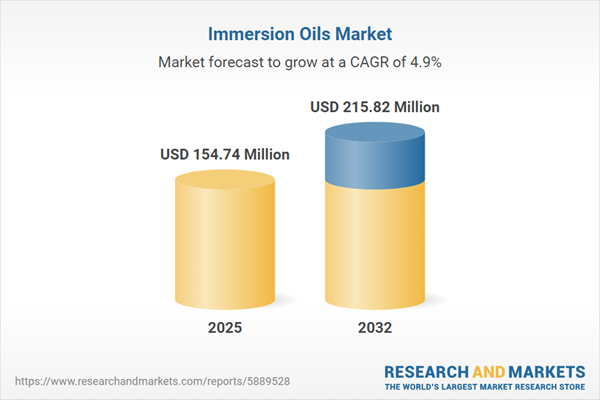Speak directly to the analyst to clarify any post sales queries you may have.
The immersion oils market is becoming an essential focus for senior decision-makers tasked with optimizing procurement, compliance, and performance in research and industrial applications. As organizations navigate evolving standards, the strategic role of immersion oils in supporting operational precision and sustainable practices is rising in prominence.
Market Snapshot: Immersion Oils Market Overview
The global immersion oils market is gaining momentum, with current valuations increasing from USD 147.39 million in 2024 to USD 154.74 million in 2025. Looking ahead, the sector is anticipated to reach USD 215.82 million by 2032, representing a compound annual growth rate (CAGR) of 4.88%. This expansion is driven by expanded use in modern laboratories, the electronics industry, and the life sciences sector. The increasing diversification of applications, alongside advancements in chemical formulation for enhanced optical clarity, environmental compliance, and tailored solutions, signals a maturing market characterized by adaptability to evolving industrial requirements.
Scope & Segmentation
- Sales Channels: Options include direct sourcing, specialized distribution, full-range suppliers, and e-commerce, with each route addressing unique requirements for technical support and timely fulfillment.
- Oil Types: Mineral, semi-synthetic, and synthetic immersion oils are compatible with both established and advanced technical equipment, allowing responsive transitions in various operational settings.
- Applications: Utilized for automotive lubrication, turbine and hydraulic systems, maintenance of compressed air setups, and deployed across mining, marine, and heavy industry domains.
- End User Industries: Key industries include automotive manufacturing, marine transport, oil and gas, and power generation, each responding to shifting regulatory frameworks and a focus on durability.
- Viscosity Grades: ISO VG 32, 46, 68, and 100 grades assure reliable compatibility, ensuring seamless integration with both legacy and contemporary machinery assets.
- Regions: Comprehensive coverage spans the Americas—U.S., Canada, Mexico, Brazil, Argentina, Chile, Colombia, Peru—alongside major hubs in Europe, the Middle East and Africa, such as the UK, Germany, Saudi Arabia, and South Africa, and Asia-Pacific, including China, India, Japan, Australia, and Southeast Asian markets.
- Key Companies Analyzed: Core market players include Cargille Laboratories, Thermo Fisher Scientific, Merck KGaA, Edmund Optics, Carl Zeiss Microscopy, Leica Microsystems, Olympus, Nikon, Meiji Techno, and PolySciences, all recognized for innovation in technical solutions.
Key Takeaways for Decision-Makers
- Emergent immersion oil technologies are improving thermal stability and limiting fluorescence, ensuring reliability in workflows reliant on microscopy and precision imaging.
- Heightened regulatory and sustainability requirements are encouraging a transition toward biodegradable and bio-based immersion oils in line with global procurement trends.
- Procurement approaches increasingly blend traditional supplier engagement with digital purchasing channels to build supply chain resilience in dynamic markets.
- Rapid expansion and innovation in Asia-Pacific are introducing novel supply chain structures, creating both opportunity and the need for ongoing supplier evaluation.
- Close coordination with equipment manufacturers supports the seamless adoption of new immersion oils for upgraded and retrofitted systems, minimizing operational interruptions.
- Ensuring correct selection of viscosity grades and product specifications supports adaptation across a broad spectrum of current and legacy operational environments.
Tariff Impact: Navigating Supply Constraints
Recent U.S. tariffs on specialty chemicals have prompted many buyers to adjust sourcing strategies for immersion oils, particularly when working with Asian and European suppliers. Senior procurement teams are mitigating risks by diversifying supply partnerships, adopting alternative raw materials, and investigating nearshoring opportunities. These proactive measures help stabilize domestic operations and reinforce supplier relationships, minimizing exposure to ongoing global supply chain volatility.
Methodology & Data Sources
This comprehensive analysis is based on executive interviews, detailed reviews of scientific literature, evaluations of regulatory policies, and patent research. These data sources inform actionable strategies for procurement and operations leaders.
Why This Report Matters
- Equips leadership with up-to-date insights to align sourcing and operational tactics with contemporary sustainability and supplier requirements.
- Enables benchmarking against compliance and industry innovation standards, supporting alignment with evolving international practices.
- Provides practical guidance for navigating complex technical demands and shifting commercial priorities in both new and established markets.
Conclusion
Leadership teams that prioritize strategic innovation and supplier collaboration will be positioned to meet changing compliance needs and drive operational efficiency as the immersion oils sector evolves.
Additional Product Information:
- Purchase of this report includes 1 year online access with quarterly updates.
- This report can be updated on request. Please contact our Customer Experience team using the Ask a Question widget on our website.
Table of Contents
3. Executive Summary
4. Market Overview
7. Cumulative Impact of Artificial Intelligence 2025
Companies Mentioned
The companies profiled in this Immersion Oils market report include:- Cargille Laboratories, Inc.
- Thermo Fisher Scientific Inc.
- Merck KGaA
- Edmund Optics Inc.
- Carl Zeiss Microscopy GmbH
- Leica Microsystems GmbH
- Olympus Corporation
- Nikon Corporation
- Meiji Techno Co., Ltd.
- PolySciences, Inc.
Table Information
| Report Attribute | Details |
|---|---|
| No. of Pages | 189 |
| Published | November 2025 |
| Forecast Period | 2025 - 2032 |
| Estimated Market Value ( USD | $ 154.74 Million |
| Forecasted Market Value ( USD | $ 215.82 Million |
| Compound Annual Growth Rate | 4.8% |
| Regions Covered | Global |
| No. of Companies Mentioned | 11 |









